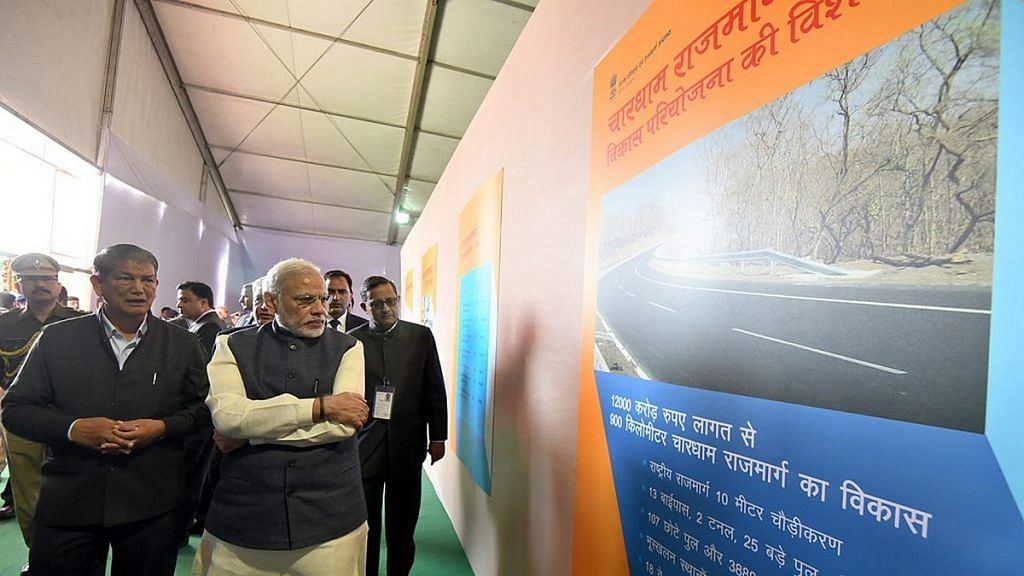New Delhi: The Ministry of Defence has moved the Supreme Court to modify its 8 September order and allow a 7-metre-wide two-lane road in some parts of the 900-kilometre Char Dham highway project.
The ministry has cited serious repercussions on the defence of the country and its security interests, which “is in jeopardy, especially in the background of today’s sensitive situation existing at the Chinese border”.
The three stretches where the defence ministry wants to widen the road connect the Army and Indo-Tibetan Border Police stations located at Joshimath, Uttarkashi, Roorkee, Rajwala, Dehradun, Tanakpur, Pithoragarh and other places to the International Border/Line of Actual Control with China.
The application came up for hearing Wednesday before a bench led by Justice Rohinton F. Nariman. The bench asked the court-appointed high-powered committee (HPC) to consider it within two weeks and submit a report.
Also read: Highways ministry ‘flouting’ SC order in Char Dham project, top court takes suo moto cognisance
Why road width is an issue
The SC had, on 8 September, ordered that the road width on the entire stretch — in the ecologically fragile Himalayan region — should be 5.5 metres, according to the Union Ministry of Road Transport and Highways’ 2018 guidelines for major roads built in mountainous terrain. This was also recommended by the HPC.
The 2018 guidelines had replaced the ones issued in 2012, which said the width of a two-lane road with paved shoulder would be fixed at 10 metres.
Of the total 816-km stretch of the Char Dham route that is being expanded, the highway ministry has already done hill cutting for building a 10 metre-wide road for a 537-km stretch. It has already finishing build 365 kms of the road.
The defence ministry’s fresh application, filed Tuesday, said in view of the “recent face-off with Nepal on the Lipulekh side in 2020, all these sectors are highly sensitive”, and “critical for movement of security forces, deployment pattern, and mobilisation in case of emergency”.
The application is part of an ongoing case between a Dehradun-based NGO and the Centre on the Char Dham project. The new plea has further deepened the legal imbroglio surrounding the Rs 12,000 crore highway project, at a time when the Narendra Modi government is pushing for its quick completion.
Strategic importance of Char Dham project
Once complete, the Char Dham highway will not only improve road connectivity to the Hindu pilgrimage sites of Yamunotri, Gangotri, Kedarnath and Badrinath, but also bolster border infrastructure at a time India and China are engaged in a tense standoff.
These roads have to be made suitable and motorable for “quick mobilisation” of tanks, weapons, artillery and electronic equipment in all weather conditions, the ministry said in its application.
The Centre had been in favour of a two-lane highway with a width of seven metres. However, some members of the HPC, including its chairman Ravi Chopra, opposed the Centre’s proposal, contending it would be dangerous for the fragile Himalayan ecology that is highly susceptible to landslides. In its report, the HPC had cited the Chief of Army Staff’s statement made in September 2019 that said the requirements of the Army in the Bhagirathi eco-sensitive zone are adequately fulfilled by existing roads.
The needs of the Army were “unfortunately mentioned in passing” during the hearing of the case, the defence ministry’s application mentioned.
The plea added that the Army has been using the roads since the 1962 war with China. Initially, the need was to ensure connectivity to the border areas for troops, and hence single roads were constructed. But the situation on ground has changed significantly from the “beginning of this year”, and it has become “imperative that men and equipment should move swiftly from army stations to the Indo-China border points”.
“The movement would involve trucks carrying troops and equipment, and when the vehicles are returning from the border, they should be able to cross the vehicles going in the opposite direction without causing road-blocks or slowing down to a dead halt,” it stated.
‘MoD suggesting super-wide highway’
Senior advocate Colin Gonsalves, appearing for the Citizens for Green Doon, on whose petition the SC had issued its 8 September order, told ThePrint that the “MoD is suggesting a super-wide highway that will result in harming its own jawans”.
He also pointed out: ‘The Chief of Army Staff had last year publicly remarked there is no need for any other road other than the existing one because the Army transports its artillery by helicopters.”
Meanwhile, Chopra, chairman of the HPC, told ThePrint: “The committee will hold a meeting in the next two weeks to consider all issues before it and submit its report to the court, as it has ordered.”
Also read: Modi govt built 1.5 km of highway per day in Northeast, up from 0.6 km per day by UPA
